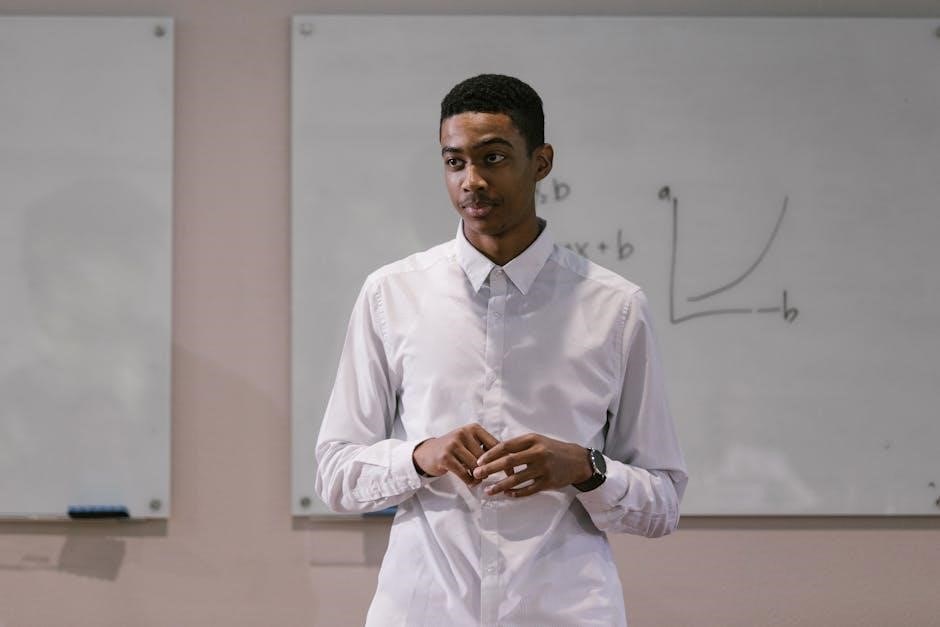
building thinking classrooms in mathematics pdf
Building Thinking Classrooms in Mathematics introduces educators to Peter Liljedahl’s transformative approach, emphasizing tasks, collaboration, and problem-solving to create dynamic learning environments, moving beyond traditional teaching methods.
Overview of the Book by Peter Liljedahl
Peter Liljedahl’s Building Thinking Classrooms in Mathematics offers a comprehensive guide to transforming traditional math education into a dynamic, student-centered environment. Drawing on over 15 years of research, Liljedahl outlines 14 optimal practices designed to foster deep mathematical thinking, collaboration, and problem-solving. The book challenges institutional norms in education, providing practical strategies for teachers to create a culture of inquiry. It emphasizes the importance of rich mathematical tasks, perseverance, and feedback, while addressing common challenges educators face. With case studies and step-by-step guides, this resource empowers teachers to shift from passive instruction to active engagement, fostering a growth mindset in students. Liljedahl’s approach has gained widespread acclaim for its potential to revolutionize math education, making it an essential read for educators at all levels.
The Concept of a Thinking Classroom

A thinking classroom is an educational environment that prioritizes active engagement, collaboration, and critical thinking over passive learning. It is characterized by students being deeply invested in problem-solving, inquiry, and mathematical reasoning. Unlike traditional classrooms, where the teacher is the primary source of information, a thinking classroom empowers students to take ownership of their learning. This approach fosters a culture where students are encouraged to ask questions, explore ideas, and persevere through challenges. The teacher acts as a facilitator, guiding students rather than delivering content. Rich mathematical tasks are central to this model, as they provide the catalyst for meaningful discussion and deeper understanding. A thinking classroom is not just about academic achievement but also about cultivating a growth mindset, creativity, and resilience in students. It represents a fundamental shift in how mathematics is taught and learned, focusing on process over procedure.
The Importance of Thinking in Mathematics Education
Thinking is the cornerstone of meaningful mathematics education, as it enables students to engage deeply with concepts, develop problem-solving skills, and connect ideas across contexts. Traditional math instruction often focuses on procedural fluency, but fostering critical thinking ensures students understand the “why” behind the “how.” This approach not only enhances academic performance but also prepares students for real-world challenges, where creative and analytical skills are essential. By prioritizing thinking, educators help students move beyond rote memorization to a richer, more conceptual understanding of mathematics. This shift nurtures perseverance, curiosity, and a growth mindset, empowering students to embrace complexity and view math as a tool for exploration and innovation. Ultimately, thinking in mathematics education cultivates lifelong learners capable of adapting to an ever-changing world.

The 14 Optimal Practices for Thinking Classrooms
Peter Liljedahl’s 14 optimal practices create a setting for deep mathematical thinking, collaboration, and problem-solving, transforming classrooms into vibrant learning environments that prioritize student engagement and conceptual understanding.
Practice 1: Tasks That Promote Thinking

Practice 1 emphasizes using tasks that encourage critical thinking and problem-solving. Liljedahl suggests beginning with non-curricular tasks to engage students in thinking and problem-solving, setting the foundation for a thinking classroom. These tasks are not tied to specific standards, allowing students to focus on reasoning and collaboration. Open-ended problems that require mathematical reasoning are central, fostering deeper engagement and a culture of inquiry. By introducing such tasks, teachers create an environment where students are encouraged to explore, question, and think deeply. This practice shifts the focus from rote learning to fostering a mindset that values problem-solving and critical thinking, preparing students to tackle complex mathematical challenges with confidence and curiosity.
Practice 2: Creating a Culture of Inquiry
Creating a culture of inquiry involves fostering an environment where students feel safe to explore, question, and investigate mathematical concepts. This practice encourages teachers to shift from being the primary source of information to facilitators of learning. By asking open-ended questions and encouraging student-led discussions, teachers promote deeper engagement and understanding. A culture of inquiry values curiosity and perseverance, allowing students to take ownership of their learning. This approach also helps students develop the habit of questioning and seeking answers, which is essential for critical thinking. Implementing this practice requires intentional strategies to encourage student voice and agency, ensuring that every learner feels empowered to participate and contribute to the mathematical dialogue in the classroom.
Practice 3: The Role of Collaboration
Collaboration plays a vital role in building thinking classrooms, as it encourages students to engage in shared problem-solving and mathematical dialogue. By working together, students learn to articulate their thoughts, listen to others, and refine their understanding. This practice fosters a sense of community and reduces math anxiety, creating a supportive environment where students feel comfortable taking risks. Collaboration also allows teachers to observe and guide students’ thinking processes, providing timely feedback. Research highlights that collaborative learning enhances critical thinking and communication skills, essential for deep mathematical understanding. Teachers can facilitate collaboration through structured group tasks, ensuring that all students contribute and learn from one another. This approach not only enriches the learning experience but also prepares students for real-world scenarios where teamwork is essential.
Practice 4: Encouraging Problem Solving
Encouraging problem-solving is a cornerstone of building thinking classrooms, as it equips students with the skills to navigate complex mathematical challenges. Teachers can foster this by presenting tasks that require critical thinking rather than procedural fluency. Open-ended questions and non-curricular tasks allow students to explore multiple solutions, fostering creativity and resilience. By refraining from providing immediate answers, educators encourage students to persevere through difficulties. This practice also involves creating a safe environment where errors are viewed as learning opportunities. Research shows that students who engage in problem-solving develop a deeper understanding of mathematical concepts and improved reasoning abilities. Regular exposure to such tasks helps students become confident, independent thinkers prepared to tackle real-world problems.
Practice 5: The Use of Rich Mathematical Tasks
Rich mathematical tasks are essential for fostering deep thinking and engagement in the classroom. These tasks are open-ended, non-curricular, and designed to challenge students to think critically. Unlike traditional problems, they often have multiple solutions and require students to explore and justify their reasoning. Rich tasks encourage collaboration, as students share strategies and learn from one another. They also promote a growth mindset by allowing students to grapple with complexity and embrace mistakes as learning opportunities. By incorporating such tasks, teachers create an environment where students develop problem-solving skills and a deeper understanding of mathematical concepts. This approach ensures students are prepared to tackle real-world challenges with confidence and creativity.
Practice 6: Facilitating Deep Understanding
Facilitating deep understanding in mathematics requires teachers to move beyond surface-level knowledge and foster environments where students engage meaningfully with concepts. This practice involves using open-ended questions and rich tasks that prompt students to explore, analyze, and connect ideas. Teachers should encourage students to justify their reasoning and reflect on their learning, helping them build a robust foundation of mathematical knowledge. Collaboration and problem-solving are key, as students learn to articulate their thoughts and learn from one another. By shifting the focus from procedural fluency to conceptual understanding, teachers empower students to think critically and apply mathematics to real-world scenarios. This approach aligns with other optimal practices, such as the use of rich tasks and fostering a culture of inquiry, to create a cohesive and impactful learning experience.
Practice 7: The Importance of Perseverance
Perseverance is a cornerstone of a thinking classroom, as it encourages students to embrace challenges and persist through difficulties. Peter Liljedahl emphasizes that fostering perseverance helps students develop resilience and a growth mindset, essential for deep mathematical understanding. Teachers play a critical role by modeling problem-solving behaviors and encouraging students to view obstacles as opportunities for growth. By creating a supportive environment, educators can help students overcome the fear of failure, fostering confidence in their ability to tackle complex tasks. Perseverance also promotes a culture of inquiry, where students are willing to explore multiple strategies and learn from their mistakes. This practice aligns with the broader goal of developing critical thinkers who are prepared to navigate challenges in mathematics and beyond.
Practice 8: The Role of Feedback in Thinking Classrooms
Feedback plays a pivotal role in thinking classrooms, serving as a tool to guide students toward deeper understanding and problem-solving proficiency. According to Peter Liljedahl, effective feedback should be immediate, specific, and focused on advancing students’ thinking rather than providing direct answers. This approach ensures that students remain engaged and motivated, as they receive clarity on their progress without being spoon-fed solutions. Feedback in a thinking classroom is not about correcting mistakes but about fostering growth and encouraging students to reflect on their learning. By structuring feedback to prompt further inquiry, teachers create an environment where students take ownership of their learning and develop the confidence to explore complex mathematical concepts independently.
Practice 9: Strategies for Debriefing
Debriefing is a critical strategy in thinking classrooms, allowing students to reflect on their problem-solving processes and consolidate their learning; Peter Liljedahl emphasizes the importance of structured debriefing sessions to discuss strategies, challenges, and insights gained during tasks. This practice helps students articulate their thinking, identify misconceptions, and solidify mathematical concepts. Effective debriefing involves guiding students to analyze their approaches, compare solutions, and reflect on what worked well and what didn’t. It also provides an opportunity for teachers to highlight key mathematical ideas and connections. By making debriefing a consistent practice, teachers foster a culture of collaboration, resilience, and deeper understanding, ensuring that students are prepared to approach future challenges with confidence and a growth mindset.
Practice 10: The Role of the Teacher in a Thinking Classroom
In a thinking classroom, the teacher’s role shifts from being the primary source of information to facilitating and guiding student-centered learning. Peter Liljedahl highlights the importance of teachers creating an environment where students feel safe to explore, take risks, and engage deeply with mathematical concepts. This involves posing open-ended questions, encouraging student-led discussions, and strategically intervening to deepen understanding. Teachers must also manage classroom flow, ensuring tasks are accessible yet challenging, and provide timely, constructive feedback that fosters persistence; By modeling a growth mindset and valuing diverse problem-solving approaches, teachers empower students to become confident, independent thinkers. The teacher’s role is not to provide answers but to guide students in uncovering them, thereby cultivating a culture of inquiry and collaboration.
Practice 11: Managing Classroom Flow
Managing classroom flow is crucial for maintaining a productive and engaging learning environment. Peter Liljedahl emphasizes the importance of smooth transitions between activities, clear task instructions, and strategic timing to keep students focused and motivated. Effective flow ensures that rich mathematical tasks are accessible yet challenging, encouraging active participation and collaboration. Teachers must balance between structured guidance and student autonomy, allowing for flexibility while maintaining momentum. Implementing strategies like timed activities, visual cues, and organized group work helps prevent disruptions. Additionally, integrating feedback and assessment seamlessly into the flow supports continuous learning without halting progress. By thoughtfully managing classroom flow, educators create a dynamic and efficient space where students can think deeply, explore concepts, and develop problem-solving skills without unnecessary interruptions or distractions. This practice is essential for fostering a thinking classroom environment.
Practice 12: The Role of Assessment
In a thinking classroom, assessment is a critical tool for understanding student progress and fostering growth. Peter Liljedahl advocates for assessments that reveal students’ mathematical reasoning and problem-solving processes, rather than mere answers. Formative assessments, such as observing student interactions and reviewing their work, provide insights into their thinking and help identify misconceptions. These assessments should align with the rich mathematical tasks used in the classroom, ensuring they measure deeper understanding rather than surface-level knowledge. Additionally, assessments should be designed to encourage perseverance and further exploration, rather than halting the thinking process. By integrating assessment seamlessly into the learning environment, teachers can guide students toward greater mathematical proficiency while maintaining a culture of inquiry and collaboration.
Practice 13: The Importance of Reflection
Reflection is a cornerstone of a thinking classroom, enabling students to deepen their understanding and connect their learning experiences. Peter Liljedahl emphasizes the value of reflective practices, such as debriefing sessions and reflective journaling, to help students analyze their problem-solving processes. Reflection encourages students to identify strengths, weaknesses, and areas for growth, fostering a growth mindset. By regularly reflecting on their thinking, students develop a greater awareness of their learning and the strategies they employ; This practice also helps teachers gain insights into student progress and understanding. Reflection not only enhances mathematical proficiency but also cultivates critical thinking and self-directed learning. Ultimately, it empowers students to take ownership of their learning journey, making reflection an indispensable component of a thinking classroom.
Practice 14: Creating a Growth Mindset
Creating a growth mindset is essential for fostering resilience and confidence in students. Peter Liljedahl highlights the importance of encouraging students to view challenges as opportunities for growth rather than obstacles. A growth mindset shifts the focus from ability to effort, emphasizing that intelligence and mathematical understanding can be developed over time. Teachers play a crucial role in modeling and promoting this mindset by celebrating persistence, providing constructive feedback, and framing failures as learning experiences. By embedding a growth mindset into the classroom culture, students are empowered to approach problems with curiosity and confidence. This practice not only enhances mathematical proficiency but also equips students with a lifelong skill for tackling challenges in all areas of life.

Implementing the Practices in the Classroom
Teachers can start by introducing non-curricular tasks to foster problem-solving and collaboration. This approach sets expectations for thinking classrooms, encouraging deeper engagement and mathematical inquiry from day one.

Step-by-Step Guides for Teachers
Teachers can begin by introducing non-curricular tasks to spark problem-solving and collaboration. Start with open-ended questions that encourage critical thinking and reduce “stop-thinking” queries. Use rich mathematical tasks that challenge students and promote deeper understanding. Facilitate debriefing sessions to reflect on problem-solving processes and outcomes. Provide constructive feedback that guides students without giving away answers. Encourage perseverance by normalizing struggle and celebrating effort. Foster a culture of inquiry by asking open-ended questions and allowing students to explore concepts independently; Incorporate collaborative activities to enhance peer learning and shared reasoning. Ensure tasks align with curriculum goals while maintaining flexibility for student-led exploration. Offer step-by-step support for new teachers to manage classroom flow and implement practices effectively. These strategies help create a dynamic, student-centered learning environment focused on fostering mathematical thinking and problem-solving skills.

Case Studies of Successful Implementations
Case studies highlight successful adoption of thinking classrooms in mathematics, showcasing transformative outcomes. A teacher implemented Liljedahl’s practices, shifting from lectures to collaborative problem-solving, resulting in increased student engagement and deeper conceptual understanding. Students developed perseverance and confidence in tackling complex tasks. Debriefing sessions became pivotal, allowing reflection and shared learning. The classroom evolved into a vibrant, inquiry-driven environment where students took ownership of their learning. This implementation demonstrates how structured strategies can foster a culture of thinking and collaboration, leading to improved mathematical proficiency and a growth mindset among students. These real-world examples provide tangible evidence of the positive impact of building thinking classrooms in mathematics education.
Common Challenges and Solutions
Implementing thinking classrooms in mathematics often presents challenges, such as managing classroom flow and effectively debriefing topics. Teachers may struggle with avoiding “stop-thinking” questions that hinder critical thinking. Additionally, the transition from traditional teaching methods to collaborative, inquiry-based learning can be daunting. To address these challenges, educators can benefit from professional development and structured strategies. For instance, using rich mathematical tasks and fostering a growth mindset helps students persevere through complex problems. Encouraging collaboration and providing constructive feedback also supports deeper understanding. By addressing these challenges with targeted solutions, teachers can create dynamic learning environments that prioritize thinking and problem-solving, ultimately enhancing student engagement and mathematical proficiency.

The Role of the Teacher in a Thinking Classroom
Teachers in thinking classrooms shift from lecturers to facilitators, fostering critical thinking, collaboration, and a growth mindset, creating an environment where students take ownership of their learning.
Facilitation Strategies for Teachers
Facilitating a thinking classroom requires teachers to adopt specific strategies that promote active engagement and deep mathematical thinking. This includes using open-ended questions, active listening, and fostering a collaborative environment. Teachers should encourage students to explore problems independently before guiding them toward solutions. Managing classroom flow effectively ensures that tasks are neither too simplistic nor overly complex. Providing timely, constructive feedback is crucial, as it helps students refine their thinking without discouraging creativity. Additionally, teachers must avoid “stop-thinking” questions that hinder critical exploration. By modeling curiosity and perseverance, educators create a culture where students feel safe to take risks and learn from mistakes. These strategies empower teachers to shift from being knowledge dispensers to facilitators of meaningful mathematical inquiry and growth.
Managing the Classroom Environment
Creating an effective classroom environment for thinking classrooms involves intentional structuring to promote collaboration, curiosity, and problem-solving. Teachers must establish clear expectations that value deep thinking over speed or correctness. The physical space should be organized to encourage movement and interaction, with flexible seating arrangements that foster small-group work. Additionally, minimizing disruptions and creating a culture of respect are essential. Teachers should model patience and persistence, allowing students time to grapple with challenges. The environment should also include visible reminders of mathematical concepts and student work to inspire engagement. By carefully managing these elements, educators can cultivate a space where students feel empowered to explore, take risks, and develop a growth mindset. This intentional approach ensures that the classroom becomes a vibrant hub of mathematical thinking and learning. Avoiding rigid structures allows for adaptability, ensuring the environment evolves with student needs.
Professional Development for Teachers
Professional development is crucial for teachers implementing thinking classrooms, as it equips them with strategies to facilitate deep mathematical thinking. Workshops, coaching, and collaborative learning environments help educators adapt their teaching practices. Resources like the Building Thinking Classrooms in Mathematics guide provide actionable strategies, such as managing classroom flow and effective debriefing. Teachers learn to create cultures of inquiry and collaboration, fostering perseverance and problem-solving skills in students. Ongoing training emphasizes the importance of rich mathematical tasks and formative assessments. By engaging in professional development, teachers gain confidence in navigating the complexities of a thinking classroom, ultimately enhancing student engagement and understanding. This continuous learning ensures educators remain effective facilitators of deep mathematical thinking and growth mindsets in their students.

Benefits and Challenges of Thinking Classrooms
Thinking classrooms foster engagement, deeper understanding, and collaboration but require proper strategic management and teacher training to address initial challenges and ensure effective implementation.

Enhancing Student Engagement and Understanding
Thinking classrooms significantly enhance student engagement by shifting from passive learning to active problem-solving and collaboration. Rich mathematical tasks encourage deeper understanding and critical thinking, fostering a culture of inquiry. Students are motivated to explore concepts independently, developing perseverance and confidence. Collaboration among peers promotes shared learning and reduces reliance on the teacher for answers. The emphasis on questioning and discussion ensures that students are actively engaged, leading to a more profound grasp of mathematical concepts. This approach not only improves academic performance but also prepares students to tackle real-world problems effectively. By prioritizing thinking, classrooms become dynamic environments where students thrive intellectually and socially.
Addressing Common Misconceptions
Building Thinking Classrooms challenges traditional beliefs that mathematics education should focus solely on procedural fluency. It addresses the misconception that students must be constantly guided, instead emphasizing the value of students exploring and discovering concepts independently. Another common misconception is that thinking classrooms are disorganized, but in reality, they require intentional structuring and facilitation. By shifting the focus from rote memorization to critical thinking, educators can help students move beyond surface-level understanding. This approach also dispels the notion that mathematics is solely about speed and accuracy, highlighting instead the importance of reasoning and problem-solving. Addressing these misconceptions fosters a more inclusive and intellectually stimulating learning environment.